There are four versions in the Les Moulins Mahjoub “Family of Harissas” and when my samples arrive in the mail one afternoon, you bet I tear right into the box! I decide to pop open the Organic Tunisian Baklouti Harissa. I can smell deep notes of red pepper immediately–and the color of the smooth harissa is a vibrant yet somehow softer orangish-red hue than the other three more coarsely blended, deep red harissas in the Les Moulins Mahjoub line. After rummaging in my fridge, I decide to toast some sourdough bread, smear on the harissa and top it with a fried egg and pickled vegetables. The Baklouti peppers definitely offer a hearty kick of spice which was perfect with the runny yolk and tangy vegetables. The other three harissas would have to wait for another day–or at least until dinner. My on-the-fly toast was certainly not a traditional preparation (although I will tell you some of those too), but I’m pretty sure the Mahjoub family would happily encourage using harissa liberally and joyfully–in any way your little harissa-loving heart desires!
So what is “harissa”? Seems like a good place to start.
The famous Tunisian sundried ground pepper condiment “harissa” comes from the Arabic word ihares, which means “to crush.” Sounds pretty simple–not exactly fussy, or “precious” as I refer to food dishes that require long-handled culinary plating tweezers to precisely—or preciously— assemble. And, hey, there’s most definitely a time and place for culinary tweezers. But with harissa, think more spoonfuls, dollops, and smears than tweezers.
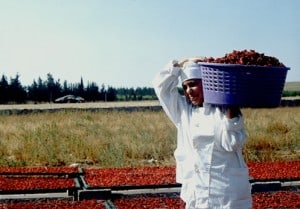
Harissa is eaten all over North Africa and, as you might imagine, each region has a different version of the spicy dried chile spread. But the variations go beyond region: within each family you will find nuances and subtle to not-so-subtle distinctions between each family recipe.
Well, the Mahjoub family has created four unique harissas. In the lush Mejerda Valley in Tunisia, this family is embracing and honoring the ancient Berber and Andalusian traditions of the land in their growing, harvesting, preserving and packaging. Without further ado, here are their four Tunisian harissas (all organic!): Traditional Harissa; Sundried Tomato Harissa; Sweet Pepper Harissa Spread; and Baklouti Harissa. Some use fresh peppers and others sundried peppers. The Sweet Pepper Harissa (known as Piment H’rouss) uses fresh peppers for a lighter, sweeter flavor than the other sundried, more concentrated-in-flavor harissas. For every 100 pounds of fresh peppers, they end up with 5 pounds of dried peppers. But whether fresh or sundried, every one of the Mahjoub harissas is organic. Each jar is rooted in Mahjoub’s deep Tunisian roots and commitment to patience, passion, integrity, and sometimes, well, a bit of poetry.
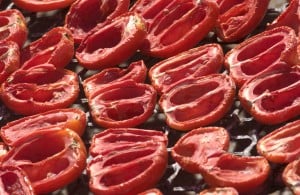
“Its flame, lingering on in my fragile memory, has marked me, just like all the other children, with all its sensation. Connected in my mind with the blessed taste of my mother’s first kisses, I swear it brings along the Milky Way to my mouth.”
These are the words of Majid Mahjoub. Although Majid has the business-y title of head of promotion and marketing for LMM, he speaks eloquently and poetically about the Mahjoub family farm he runs along with his seven sisters, two brothers and three nephews.
In December of 2017 Rogers Collection team was fortunate to travel to Tunisia to meet the Mahjoub family. They visited their farm and witnessed in person their passion, dedication and poetic nature by which they craft their products. Wish you could, too? Check out our video and peer into the world of Majid, the tradition of his land, its history, the territory, and the beauty behind Les Moulins Mahjoub peculiar products, shot beautifully by Filmmaker & Portraiture Artist Jason Goodman:
Like Majid, Jason has a poetic perspective on the culinary experience that blends history, tradition, the land and the people. He says of his experience to the Mahjoub farm, “Not many times in life do you meet such grace and vision as you do with someone like Majid. He is a mystic of pure ingredients. Always on the search for the ultimate taste–like a poet chef, he wants to put you in the moment where the past and present collide. The history of the Saharan desert, the jewels of his south Mediterranean cuisine, the sun and winds of Africa, the moment when you laugh and cry at the same time…to him it’s all this that he brings to your plate.”
Jason’s affinity for Mahjoub’s products led him to create a harissa butter with clams in Maine this summer (photo on left). More on recipes later!
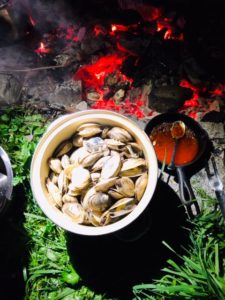
Eager to share the Mahjoub experience, Majid extends warm and sincere invitations to visit Les Moulins Mahjoub to many people. Ari Weinzweig, co-founder of Zingerman’s Community of Businesses in Ann Arbor, Michigan, took a trip to visit Les Moulins Mahjoub after much encouragement from Majid. Ari says, “I had pretty high expectations going in…But even those high expectations were exceeded.”
Ok, where was I? Off in Tunisia, truth be told. It’s easy to be transported by Mahjoub zeal and their passion-packed products. It is–in all honesty–downright contagious.
But let me rein it in for a moment and give you the straightforward scoop on the Les Moulins Mahjoub harissa line, and how to use them.
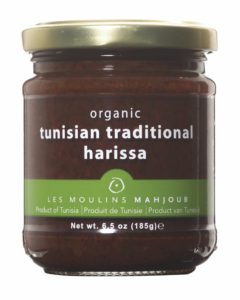
So, how do you use this condiment? Well, liberally and on anything that sounds good to you, but here are a few traditional recipes.
Lablabi is a classic Tunisian dish that Ari calls “basically the soul food of the Tunisian kitchen,” and “street food at its finest…it’s filling, it’s healthy, and it’s delicious.” Lablabi combines chickpeas with their steaming hot broth scooped over bits of bread and topped with capers, olive oil, cumin, harissa, often a coddled egg and chopped pickled lemon. See recipe here!
And speaking of pickled lemon, Majid has some thoughts there. He says, “Nothing, indeed, could be better to accompany harissa–the red pepper taste–than preserved lemon….harissa and preserved lemon are in the Tunisian cooking…destroying linear tastes, travelling from one product to the other is an opportunity to experience the feelings of excessiveness, the secrets of the overflowing expressionism of the passionate embrace, leading to the fragile intimacy and the refined elegance.”
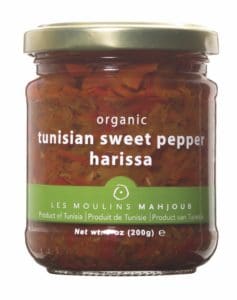
(And, psst! If you like the sound of the preserved lemon-harissa combination, try another favorite–Harissa Marinated Chicken with Preserved Lemon)
Up next: one of the Mahjoub family favorites, Ojja. This dish blends classic Mediterranean ingredients such as tomatoes, chiles, garlic, olive oil and eggs with some typical North African components like cumin and, of course, harissa. While visiting, Ari was treated to Majid’s wife Onsa’s ojja. Her ojja starts with a healthy dose of olive oil then the addition of tomato puree, sundried garlic, and the traditional sundried harissa. See recipe here!
Another classic is Shoof Book Jashe Tagine–a dish cooked over two clay pots. The recipe calls for tomatoes, garlic, green peppers, onion, olive oil, and Mahjoub Traditional Harissa. Bring it all to a boil in the clay pot over a fire, add coriander and lightly beaten eggs. Voila!
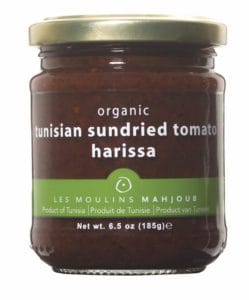
These are classic North African/Southern Mediterranean dishes calling for harissa, but this spicy spread is meant to be enjoyed around the globe–and it most certainly is! This summer, New York City-based food writer Luke Pyenson wrote high-praise for harissa in the Washington Post after discovering a Tunisian Fricassee sandwich in Paris a few years ago while on tour in Europe with his indie rock band. It has become a bit of a tradition for Pyenson to seek out the tuna-egg-potato-harissa sandwich when he’s back in Paris. But he decided recently to try out his own recipe at home. He wanted to use a bread accessible to most people, so he chose his “dependable friend…Martin’s Potato Roll.” He toasts the roll in a hot skillet with olive oil then spreads the bread with harissa. Next, he assembles the sandwich with cooked egg and potato slices, flaked canned tuna, and tops with olives (you choose: kalamata, green, or oil-cured black!). See recipe here!
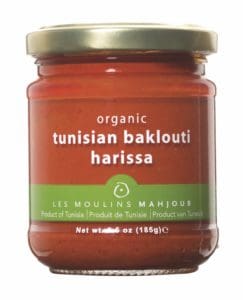
In the cookbook “Discovering Tunisian Cuisine,” by Judith Dwan Hallet, Raoudha Guellali Ben Taarit and Hasna Trabelsi, Taarit shares her recipes and reflections. She says, “I discovered how overlooked my country’s cuisine was by the rest of the world. Most people, including chefs, do not realize how closely tied the Tunisian cuisine is to the entire Mediterranean culinary experience.”
It’s time for Tunisian cuisine to shine–and harissa can lead the way!
Majid made it very clear to Ari that harissa “was basically the condiment that helped the cuisine of the poor peoples of North Africa come alive. There is without question something seductive in this sauce…notes that come out all over the place but create this hot, mellifluous, marvelous set of flavors….”
Why wouldn’t you want to use this fiery little condiment–packed with passion and history–on just about everything, and everywhere around the world?
Written by Leska Tomash
ORGANIC TUNISIAN TRADITIONAL HARISSA 185g & 700g
ORGANIC TUNISIAN SWEET PEPPER HARISSA 185g